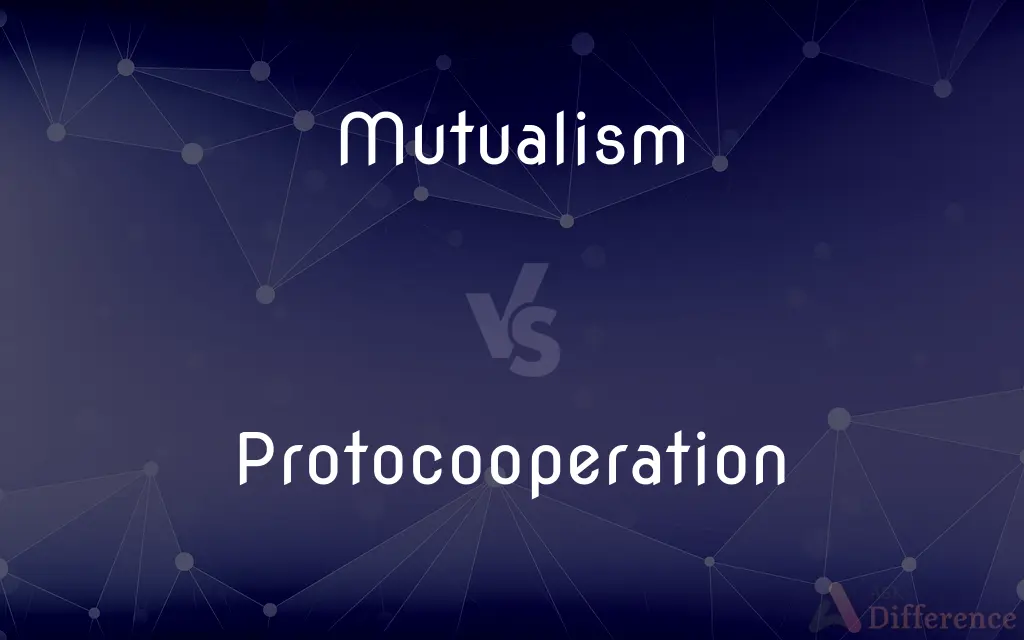Mutualism vs. Protocooperation — What's the Difference?
By Fiza Rafique & Urooj Arif — Published on November 4, 2024
Mutualism is a symbiotic relationship where both species benefit and often depend on each other for survival, whereas protocooperation is a beneficial interaction that is not obligatory for the survival of either species.

Difference Between Mutualism and Protocooperation
Table of Contents
ADVERTISEMENT
Key Differences
Mutualism represents a close and often obligatory symbiotic relationship between two species where both parties derive a significant benefit essential for their survival or reproduction. This interdependence can be so critical that one species cannot live without the other. Examples include pollinators and the flowers they pollinate, where the pollinator gets food (nectar) and the plant gets assistance with reproduction. On the other hand, protocooperation describes a relationship where two species interact in a way that is beneficial to both, but not essential for their survival. These interactions are advantageous but not obligatory, meaning both species can survive independently of the relationship. An example of protocooperation is the relationship between certain species of ants and aphids, where ants protect the aphids from predators and in return, feed on the honeydew produced by the aphids.
Mutualistic relationships often involve a high degree of specialization between the involved species, leading to co-evolution, while protocooperative relationships may be more generalized and involve less intimate interactions. In mutualism, the evolutionary paths of the involved species can be closely intertwined, with each species exerting selective pressures on the other. In contrast, protocooperation does not necessarily lead to such tight evolutionary coupling, and the interactions can be more flexible and less defined by specific adaptations.
Another key difference is the degree of dependency. In mutualism, the survival of each species is often tightly linked to the presence and health of the other species, creating a strong dependency. For example, many plants and their specific pollinators have developed alongside each other, resulting in a mutualistic relationship where each is critical for the other's reproductive success. In protocooperation, while the interaction is beneficial, it does not create a critical dependency.
The dynamics of mutualism and protocooperation also differ in their stability and resilience. Mutualistic relationships, due to their obligatory nature, can be quite vulnerable to environmental changes that disrupt one partner in the relationship. Protocooperative relationships, being non-essential, may offer more flexibility and resilience, as the loss of one beneficial partner does not necessarily endanger the survival of the other.
Understanding the distinction between mutualism and protocooperation is crucial for ecologists studying ecosystem dynamics and conservationists aiming to preserve biodiversity. Recognizing the type of interactions that occur between species can help in predicting how changes in one species might affect others and the ecosystem at large.
ADVERTISEMENT
Comparison Chart
Dependency
Obligatory for survival/reproduction
Beneficial but not essential for survival
Benefit
Essential benefits to both species
Non-essential benefits to both species
Relationship
Often involves co-evolution and specialization
More generalized interaction without co-evolution
Example
Pollinators and flowers
Ants and aphids
Evolutionary Impact
Leads to closely intertwined evolutionary paths
Less impact on the evolutionary paths of the involved species
Flexibility
Less flexible, high degree of specialization
More flexible, can involve multiple partners
Resilience to Change
Vulnerable to disruptions affecting either species
More resilient, as partners can survive independently
Compare with Definitions
Mutualism
Mutualism is a symbiotic relationship where both species benefit crucially.
The bee and the flower exhibit mutualism; the bee gets nectar, and the flower is pollinated.
Protocooperation
It does not lead to a high degree of specialization.
Various bird species protocooperate with different mammals by feeding on their parasites.
Mutualism
It often involves specific adaptations between species.
The clownfish and sea anemone's mutualism is based on immunity to toxins and protection.
Protocooperation
Multiple partnerships can exist.
Cleaner fish protocooperate with multiple fish species by removing their parasites.
Mutualism
Mutualistic relationships are obligatory for the participants.
Coral reefs depend on mutualism with algae for nutrients.
Protocooperation
Participants can survive without the relationship.
Even without ants, aphids can thrive, making their interaction protocooperative.
Mutualism
Co-evolution is common in mutualistic relationships.
Hummingbirds and certain flowers have co-evolved for mutual benefit.
Protocooperation
The relationship offers resilience to environmental changes.
In protocooperation, if one species disappears, the other can still find alternative strategies for survival.
Mutualism
The loss of one species can drastically affect the other.
The extinction of a plant species can endanger its mutualistic pollinators.
Protocooperation
Protocooperation involves a beneficial but non-essential relationship.
Spider crabs and algae protocooperate; crabs get camouflage, and algae receive mobility.
Mutualism
An association between two organisms of different species in which each member benefits.
Mutualism
The doctrine of mutual dependence as the condition of individual and social welfare.
Mutualism
The relation between two different species of organisms that are interdependent; each gains benefits from the other
Common Curiosities
Is human agriculture considered mutualism or protocooperation?
Human agriculture with pollinators can be seen as a form of mutualism, where crops receive essential pollination services, and pollinators receive food sources. However, it's often managed to avoid full dependency, leaning towards protocooperation.
How does protocooperation impact biodiversity?
Protocooperation can enhance biodiversity by creating beneficial interactions among a wider range of species, promoting ecosystem stability and resilience.
What defines a mutualistic relationship?
A mutualistic relationship is defined by obligatory interdependence between species, where both derive essential benefits.
What role does co-evolution play in these relationships?
Co-evolution is more significant in mutualism, driving the development of specialized adaptations between species, whereas in protocooperation, co-evolutionary pressures are less pronounced.
How do scientists study these relationships?
Scientists study these relationships through field observations, controlled experiments, and mathematical modeling to understand the mechanisms and outcomes of these interactions.
Can mutualism turn into protocooperation?
Over evolutionary time, mutualistic relationships might evolve into less obligatory forms, resembling protocooperation, especially if alternative strategies for obtaining essential benefits arise.
How do these interactions affect ecosystem dynamics?
Both mutualism and protocooperation contribute to ecosystem complexity and stability by facilitating nutrient cycles, pollination, and other ecological processes, but mutualism often plays a more critical role in the survival of specific species.
Are there examples of mutualism in marine ecosystems?
Yes, an example is the relationship between clownfish and sea anemones, where each provides protection to the other from predators and competitors.
Can climate change affect mutualistic relationships?
Yes, climate change can disrupt mutualistic relationships by altering the habitats or life cycles of the involved species, potentially threatening their survival.
What conservation efforts are important for mutualistic relationships?
Conserving habitats that support mutualistic relationships is crucial, as is maintaining the biodiversity necessary for these interactions to persist.
Share Your Discovery

Previous Comparison
Holy Ghost vs. Holy Spirit
Next Comparison
Akinesia vs. AkathisiaAuthor Spotlight
Written by
Fiza RafiqueFiza Rafique is a skilled content writer at AskDifference.com, where she meticulously refines and enhances written pieces. Drawing from her vast editorial expertise, Fiza ensures clarity, accuracy, and precision in every article. Passionate about language, she continually seeks to elevate the quality of content for readers worldwide.
Co-written by
Urooj ArifUrooj is a skilled content writer at Ask Difference, known for her exceptional ability to simplify complex topics into engaging and informative content. With a passion for research and a flair for clear, concise writing, she consistently delivers articles that resonate with our diverse audience.














































